OPTI 2012
12th International Conference on Optimum Design of Structures and Materials in Engineering
20 - 22 June 2012
New Forest, UK
Overview and Opening Address
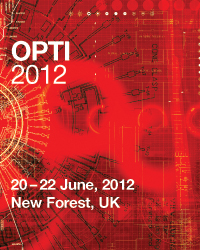
The 12th International Conference on Optimum Design of Structures and Materials in Engineering has taken place in the New Forest National Park, UK, organised by the University of A Coruña, represented by Professor Santiago Hernandez, the Wessex Institute of Technology (WIT), represented by Professor Carlos Brebbia, and the Free University of Brussels, represented by Professor Patrick de Wilde. The meeting has been sponsored by WIT Transactions on the Built Environment and the International Journal of Computational Methods and Experimental Measurements.
The OPTI conferences stated in Southampton, UK (1989) followed by Boston, USA (1991); Zaragoza, Spain (1993); Miami, USA (1995); Rome, Italy (1997); Orlando, USA (1999); Bologna, Italy (2001); Detroit, USA (2003); Skiathos, Greece (2005); Myrtle Beach, USA (2007) and the Algarve, Portugal (2009).
The main objective of the event was to provide a friendly and useful forum for networking amongst researchers, engineers from the industry and academics involved in optimization and therefore allowing them to discuss ideas, practical and theoretical approaches in design optimization and also helping them to be aware about the advances in this scientific discipline.
Currently, optimization techniques have much to offer to those involved in design in almost any engineering field because the formulation of optimum design has improved dramatically since it was mostly an academic concept unable to produce solutions for real industrial problems. The enhancement of numerical methods, the development of new optimization algorithms, the appearance of powerful commercial computer codes with easy to use graphical interfaces and the revolution in computer architecture has made possible for optimization methodologies to be an essential factor in engineering design.
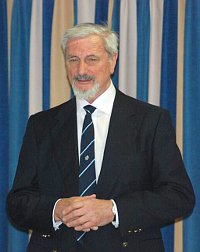
WIT also encourages all colleagues to visit the Institute Campus in the New Forest, a particularly beautiful part of the UK. There they will have an opportunity to appreciate better the work of the Institute and find ways in which to collaborate.
Carlos finished by explaining that – in addition to the conference books – WIT Press publishes a substantial number of other books, such as monographs or edited volumes. He is always happy to interact with prospective authors to put forward proposals for new titles.
Keynote and Invited Papers
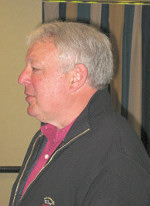
‘Limit span of cable and arch structures’
by W P De Wilde, Free University of Brussels
‘Application of particle swarm optimization to item packing problem’
by E K Kita, Nagoya University, Japan
‘Shape optimal design of phases in composites: harmonic problem’
by P Prochazka, Czech Technical University, Prague
‘Internal pressure – stressing and forming’
by I Doltsinis, University of Stuttgart, Germany
‘An application of Taguchi’s method to robust design of aircraft structures’
by S Hernandez, University of A Coruña, Spain
‘An analytical model for deformation analysis of composite wind turbine adaptive blades’
by A Maheri, Northumbria University, UK
Conference Sessions
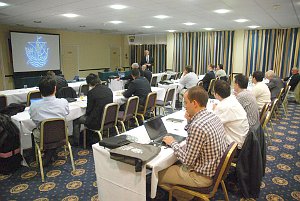 The conference attracted contributions describing case studies in engineering fields such as electrical transmission towers, masonry constructions, thin walled structures, short corbels, cable and arch structures, bridges and aircraft structures. The scope of approaches range from size to shape or topology optimization and several strategies such as meta-models, bionic procedures, isogeometric formulations, reliability methods and optimization under uncertainties can be found in the proceedings.
The conference attracted contributions describing case studies in engineering fields such as electrical transmission towers, masonry constructions, thin walled structures, short corbels, cable and arch structures, bridges and aircraft structures. The scope of approaches range from size to shape or topology optimization and several strategies such as meta-models, bionic procedures, isogeometric formulations, reliability methods and optimization under uncertainties can be found in the proceedings.
The papers were grouped according to a series of sessions, which included:
- Evolutionary methods in design optimization
- Transferable structures
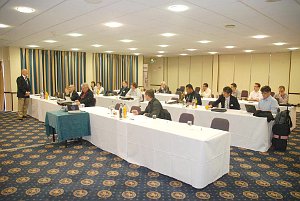 Emerging structural applications
Emerging structural applications- Optimization in civil engineering
- Shape and topology optimization
- Aerospace structures
- Structural optimization
Two of the above were special sessions. Transferable Structures was arranged by Prof Neils De Temmermans from the Free University of Brussels and comprised of four papers on these types of structure in architectural engineering, including different applications of deployable scissor structures.
The other special session was on Emerging structural applications, which was chaired by Professor W P De Wilde. It comprised of a series of interesting papers showing a variety of high performance structural and natural applications.
Eminent Scientist Medal
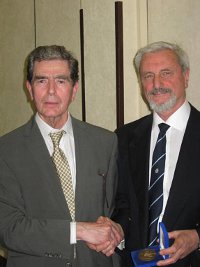
After completion of the Diploma studies, Doltsinis was invited by Professor John Argyris to join the scientific staff of the renowned Institute for Statics and Dynamics of Aerospace Structures (ISD) at the Stuttgart University. In the Institute, as a research fellow for computational nonlinear mechanics he devoted himself to the subject of engineering plasticity working on FEM elastoplastic analysis, in the focus of international efforts that time. His developments extended the range of general purpose software to the area of inelastic large scale computations in industrial engineering practice. Parallel to this work, he conducted as the project leader R&D in Wide Span Lightweight Structures (originating from the unique roof of the Olympic Stadium in Munich 1971), Nonlinear Fracture Mechanics and Composite Materials.
Continuing as the responsible scientist of the R&D on Thermomechanics and mechanics of Materials, he worked on the challenging subject of large deformation of elastoplastic solids and coupled field problems. He was the first to consistently model superplastic forming for the aerospace industry, and to develop process simulation on the grounds of hyperelasticity in a theoretically transparent and computationally efficient manner. In this context he initiated in his teams and founded the development of the Finite Element Programming Systems (FEPS) as a research tool dealing with highly nonlinear, physically coupled problems including thermomechanical deformation processes, viscous fluid motion and fluid-structure interaction. The software, conceived for research purposes, has been denoted the first handling multiphysics.
In 1984 he moved to the Institute for computer Applications (ICA) then just founded at Stuttgart University, appointed later as the Deputy Director of the Institute. The position enable interdisciplinary research along new direction: microstructural failure processes in multiphase materials, CFD for hypersonics with chemical reactions and Stochastic Mechanics. Research projects for industrial purposes refer to Plasma-sprayed Ceramic Thermal Barrier Coatings, Strength of Porous Ceramics as for the Reliability of Filtration Equipment, Re-entry Aerothermodynamics within the European Hermes Space Shuttle Programme and Stochastic Methods in Industrial Aerospace and Automotive Engineering. Most recent developments have focussed on Stochastic methods in Computational Mechanics.
Doltsinis was and is engaged as an expert consultant for Research Councils and Foundations within Germany (like Volkswagen Foundation) and abroad. He has been on the managing board of the European Research Community of Flow, Turbulence and Combustion (ERCOFTAC), belongs to the Scientific Advisory Committee of the Institute of Systems Engineering and Computers (INESC), Coimbra, Portugal, and not least, is a Fellow of the Wessex Institute of Technology.
As a Visiting Professor at the University of Trento, Italy, he transferred knowledge on advanced computational methods in engineering, Courses in the Faculty of Aerospace Engineering in Stuttgart comprise Loading Systems on Aircraft, Elastic-plastic Behaviour of Structures, Stochastic Analysis and Optimization. Research results have been published in numerous international professional journals. Based on his experience in engineering research and education, he authored the books
- Elements of Plasticity – Theory and Computation
- Large Deformation Processes of Solids – Fundamentals and Engineering Applications
- Stochastic Methods in Engineering
All of these have been published by WIT Press. The most recent one – Stochastic Methods in Engineering – has been motivated by the increasing demand in the industry for introducing uncertainty in the design process, and the necessity for acquiring fundamental background knowledge on the subject.
At the end of Ioannis’ address Carlos Brebbia presented him with the Eminent Scientist Medal given by the Wessex Institute of Technology to outstanding researchers. Awardees include renown scientists and engineers from all over the world; the first of the medals being awarded in 1986.
Book Launch
The conference was the occasion of a new book by Professor Ioannis Doltsinis of Stuttgart University, on ‘Stochastic Methods in Engineering’ that points out the importance of probabilistic models in engineering analysis and design in which to account for the random infection of actual systems.
Stochastic Methods in Engineering covers computational stochastic analysis and optimization. It begins by introducing concepts and then outlines computational approaches to specific classes of problems. Emanating from the author’s courses at the Faculty of Aerospace Engineering at the University of Stuttgart, the book is intended to make the reader familiar with the stochastic point of view, exploring and quantifying random system variability, its source and sensitivity. It also develops methods of stochastic analysis and optimization based on deterministic knowledge, serving as a guide in the transition from determinism to stochastics.
The book begins by introducing concepts of stochastic analysis and design optimization, outlining computational approaches to specific classes of problems, referring first to elastic structures, geometric nonlinearities and elastoplasticity. Two fundamentally different methods are considered in this context and are developed on the basis of the finite element formalism: the analytical Taylor expansion approach and the synthetic Monte Carlo technique. In fact, the single volume is unique in presenting tutorials on essential probabilistics and statistics, recent finite element methods, and Monte Carlo simulation techniques. The considerations are extended to the important issue of system reliability, time variant phenomena and material deformation processes. Supplementary, statistical assessment and comparison of systems is exposed, which is of interest also when validating analysis models by laboratory testing.
Social Occasions
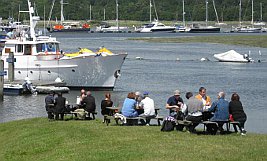
In addition they were invited to participate in a lunchtime excursion to one of the most beautiful sites in the New Forest, Bucklers Hard, to which they were taken by bus and offered a packed lunch.
Bucklers Hard is a very picturesque village of great historical interest lying on the Beaulieu River. It was a shipbuilding village, which at its height had five slipways and around 20 cottages for the workers. Only two rows of cottages now remain with a broad village street separating them and sloping towards the river. At the end of one row stands a hotel, which was the Master Builder’s house. An excellent display at the entrance of the village describes the activities that took place there.
Many fine wooden ships were built there including the famous Agamemnon, commanded by Nelson during the siege of Calvi, in which he lost the vision of his right eye. This ship, together with Swiftsure and Euryalus, all built at Buckler’s Hard, took part in the Battle of Trafalgar.
The weather was kind to the delegates who had occasion to sit on the wooden benches on the river shore and partake of their picnic lunches. They were able to walk around the place and visit the pub as well as a tiny chapel located in one of the builders’ cottages.
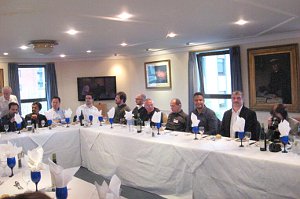
Carlos proposed a toast to the success of the meeting and in particular to Professor Ioannis Doltsinis, the receptor of the Eminent Scientist Award. At the end of the dinner Carlos offered all participants a ceramic dish, the work of a local potter who still uses traditional methods for the whole process. The pieces are works of art in their own right and will help the delegates remember the happy occasion of their visit to the Southampton area and in particular the New Forest.
During a lunch break the delegates were offered a lamb BBQ in the Campus of Wessex Institute, where they had occasion of seeing some of the latest improvements, particularly the newly built sports hall, with indoor swimming pool and gymnasium. The new building fits well within the style of the Lodge and has up to date facilities. They were also offered a tour of the main building where most of the research takes place as well as a series of other activities.
The lamb BBQ has become a tradition of Wessex Institute, the quality of lamb meat from Hampshire being renowned. The convivial atmosphere and general fare contributed to make this a unique experience for the visitors.
The International Scientific Advisory Committee (ISAC) of the conference met to discuss how the meeting has progressed and put forward new ideas for the future. The discussions centred on new topics and directions of research. The ideas put forward will be discussed by the WIT Board.
Closing of the Conference
Carlos closed the conference by thanking all participants for having come to the New Forest for the conference which gave them the opportunity to visit WIT Campus at Ashurst Lodge. He hopes that many participants now understand the objectives of the Institute and will continue to collaborate in the future.Conference Proceedings
The proceedings of OPTI, 292pp (Print ISBN:978-1-84564-598-4, eISBN 978-1-84564-599-1) are available from WIT Press. Orders can be placed on the WIT Press web site at www.witpress.com or by email: This email address is being protected from spambots. You need JavaScript enabled to view it., telephone: +44 (0) 238 029 3223 or fax: +44 (0) 238 029 2853.
Papers from the conference will also be hosted online at the WIT eLibrary as Volume 125 of WIT Transactions on the Built Environment (ISSN: 1746-4498, Digital ISSN 1743-3509). For more details visit the WIT eLibrary at http://library.witpress.com

 Wessex Institute
Wessex Institute